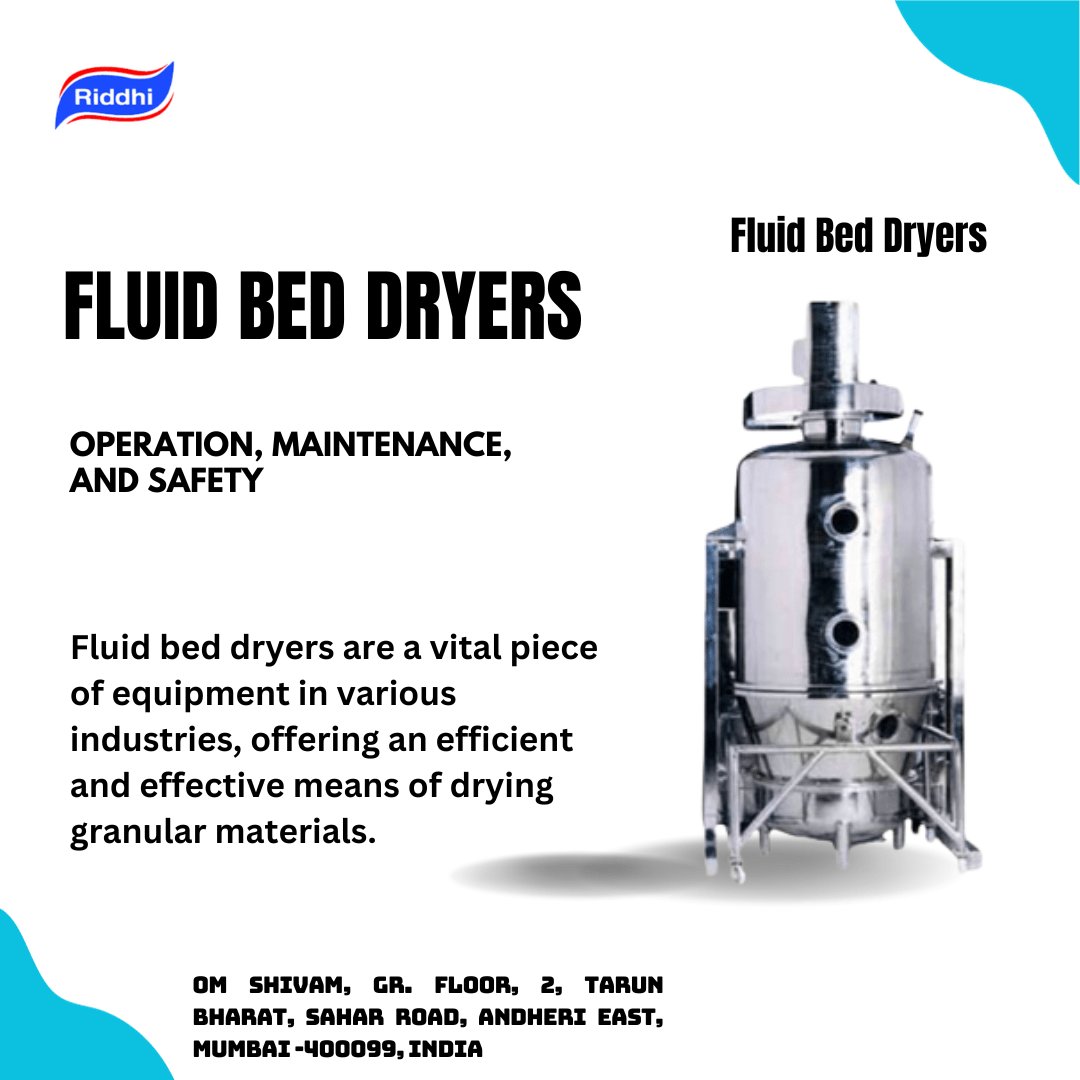Fluid bed dryers are a vital piece of equipment in various industries, offering an efficient and effective means of drying granular materials. Imagine a bed of solid particles, like sand, suspended in a stream of hot air – that’s essentially what a fluid bed dryer is all about.
The basic concept behind Fluid Bed Dryers is to create a “fluidized” or suspended state for the material being dried. This is achieved by blowing hot air or gas through a perforated plate or mesh at the base of a container filled with wet or damp material. As the air rushes through the tiny openings, it effectively lifts and mixes the particles, creating a dynamic and fluid-like bed.
Here’s where the magic happens: as the material is suspended and agitated within this fluidized bed, it gets exposed to the hot air uniformly from all directions. This results in rapid and efficient drying as moisture evaporates from the material’s surface. Think of it as a gentle, yet thorough, drying process that minimizes the risk of overheating or damaging the material.
Fluid bed dryers are prized for their versatility. They can handle a wide range of materials, from powders and granules to crystals and even some sticky substances. Plus, they offer precise control over temperature and airflow, making them a go-to choice for industries like pharmaceuticals, food processing, and chemicals, where precise drying conditions are crucial.
In a nutshell, fluid bed dryers are all about efficiently and gently drying materials by suspending them in a fluid-like state of hot air or gas. They’re a cornerstone of modern industrial processes, ensuring consistent and high-quality results across various applications.
Operating Principle of Fluid Bed Dryer:
Fluid bed dryers are ingenious devices used in various industries to efficiently remove moisture from wet materials. Let’s dive into how they operate, the concept of fluidization, and the two primary types: batch and continuous fluid bed dryers.
How Fluid Bed Dryers Work:
Material Placement: Initially, damp material is placed on a perforated bed or conveyor in the dryer chamber. This material could be anything from grains and pharmaceutical powders to chemicals and minerals.
Fluidization: As the hot air rises through the bed, it imparts energy to the material particles. When the upward force of the air equals the downward force of gravity on the particles, they become suspended in the air, essentially ‘floating’ or ‘fluidizing.’ This creates a dynamic and fluid-like state within the bed.
Drying: The fluidized particles are now in constant motion, allowing for excellent heat and mass transfer. Moisture within the particles evaporates quickly due to the increased surface area and efficient mixing.
Cooling and Collection: After drying, the material may need to be cooled. This is achieved by reducing the temperature of the inlet air or introducing a cooling air stream. The dried material is then collected from the bed.
Fluidization and Its Role:
Fluidization is the key to the efficiency of fluid bed dryers. It enables uniform drying by ensuring that each particle is exposed to the hot air, preventing clumping and uneven moisture removal. This fluidized state also minimizes the risk of overheating or damaging sensitive materials, making fluid bed dryers ideal for products that are heat-sensitive or prone to sticking together.
Types of Fluid Bed Dryers:
Batch Fluid Bed Dryers: These dryers are designed for smaller-scale operations. They load a batch of material onto the bed, dry it, and then unload it before the next batch. Batch dryers are versatile and suitable for various product types but may have longer processing times due to the loading/unloading phases.
Continuous Fluid Bed Dryers: In contrast, continuous dryers are built for large-scale, continuous production. Material is continuously fed onto the bed, dried, and discharged at the other end. This results in higher throughput and efficiency, making them well-suited for industries with high-volume production needs.
Maintaining Fluid Bed Dryers for Optimal Performance:
As one of the most experienced Fluid Bed Dryer Suppliers in India, we have listed the following tips to keep your product maintained:
Regular Cleaning: Clean the dryer regularly to prevent the buildup of dust and debris. Accumulated particles can hinder airflow and reduce efficiency.
Inspect Air Filters: Check and clean or replace air filters as needed. Clean filters help maintain proper airflow, ensuring efficient drying.
Bearing Lubrication: Lubricate bearings and moving parts as per the manufacturer’s recommendations. Proper lubrication reduces friction, extending the lifespan of components.
Seal Checks: Inspect the seals and gaskets for wear and tear. Damaged seals can cause air leaks, affecting the fluidization process and drying efficiency.
Temperature and Pressure Monitoring: Regularly monitor and calibrate temperature and pressure gauges. Accurate readings are essential for precise control of the drying process.
Material Handling: Ensure the material being processed is suitable for the fluid bed dryer and doesn’t contain any substances that could damage the equipment or pose safety risks.
Dust Collection: Maintain an effective dust collection system to minimize the risk of dust explosions and ensure a clean working environment.
Electrical Components: Periodically inspect electrical components for signs of wear, damage, or loose connections. Electrical systems that are not functioning correctly can pose safety risks.
Safety Interlocks: Ensure that safety interlocks are functioning correctly. These interlocks help prevent accidents by shutting down the equipment if safety criteria are not met.
Safety Precautions and Guidelines for Operators:
Operating fluid bed dryers efficiently is important to protect both personnel and equipment. Here are some safety precautions and guidelines for operators:
Training: Operators should receive comprehensive training on the proper use of the fluid bed dryer, including safety protocols and emergency procedures.
Protective Gear: Wear appropriate personal protective equipment (PPE), such as gloves, safety goggles, and dust masks, to safeguard against dust exposure and chemical hazards.
Ventilation: Ensure adequate ventilation in the drying area to disperse dust and prevent the buildup of potentially explosive atmospheres.
Material Compatibility: Verify that the materials being processed are compatible with the equipment and won’t create hazards, such as chemical reactions or dust explosions.
Monitor Temperature and Pressure: Continuously monitor temperature and pressure indicators during operation. Any abnormal readings should trigger an immediate investigation and, if necessary, shutdown.
Emergency Shutdown: Know how to quickly shut down the equipment in case of emergencies. This includes understanding emergency stop buttons and procedures.
Dust Control: Maintain a dust collection system to minimize dust emissions. Empty dust collectors regularly and follow safe disposal procedures.
No Open Flames: Prohibit open flames or sparks in the vicinity of the dryer, as dust clouds can be flammable.
Regular Inspections: Conduct routine inspections of the equipment to identify and address any safety concerns promptly.
Reporting: Encourage operators to report any safety hazards or equipment malfunctions immediately to supervisors.
Final Words
By following these maintenance and safety guidelines, you can ensure that your fluid bed dryer operates efficiently while minimizing the risk of accidents and maintaining a safe working environment.
Ridhi Pharma takes pride in being recognized as one of the top fluid bed dryer manufacturers in India. With a relentless commitment to quality, innovation, and customer satisfaction, we have consistently upheld our reputation as industry leaders. Our state-of-the-art facilities, seasoned experts, and cutting-edge technology ensure that our fluid bed dryers meet the highest standards of performance, reliability, and efficiency.

As the editor of the blog, She curate insightful content that sparks curiosity and fosters learning. With a passion for storytelling and a keen eye for detail, she strive to bring diverse perspectives and engaging narratives to readers, ensuring every piece informs, inspires, and enriches.










